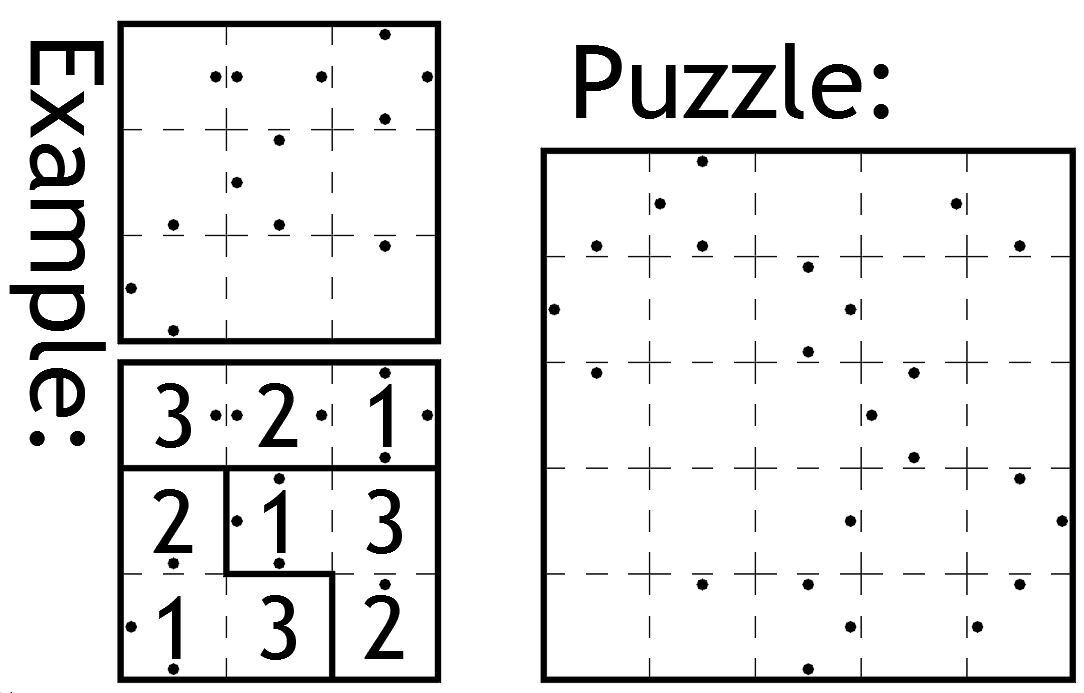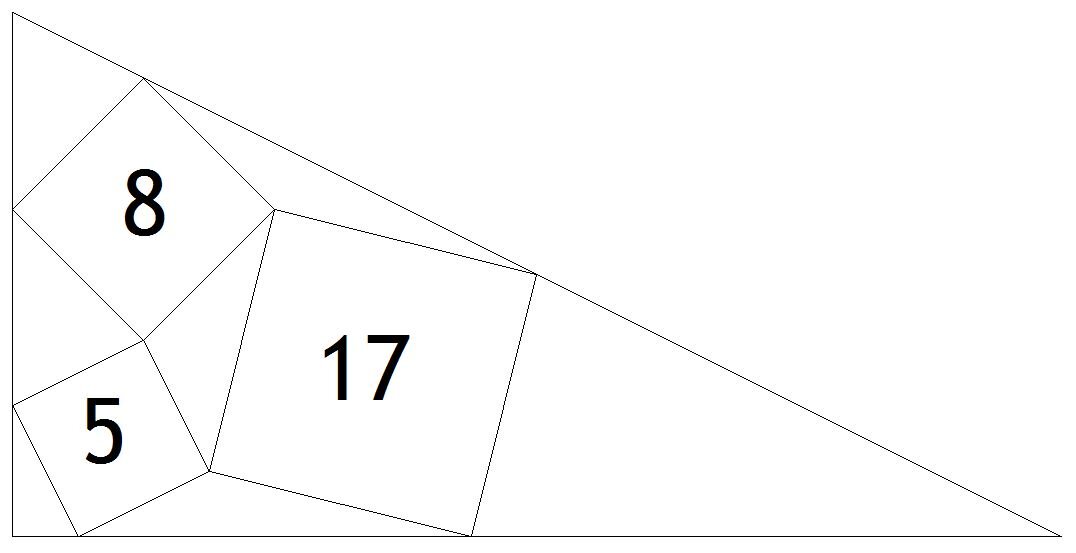1/8 + 1/188 + 1/43992 = 1/a + 1/b, where a and b are both whole numbers.
What are the values of a and b?
Your Custom Text Here
1/8 + 1/188 + 1/43992 = 1/a + 1/b, where a and b are both whole numbers.
What are the values of a and b?
a + b + c + d = 4
a^3 + b^3 + c^3 + d^3 = 4
a b c and d are all integers
There is a trivial solution where a, b, c and d are all 1, but can you find a set of numbers which satisfy the equations, none of which is equal to 1?

ABCDEFG is a regular heptagon
H, J, K, L are midpoints of sides of the heptagon.
The lines AB and EF coincide at point N.
The lines HK and JL coincide at point M.
The lines AG and CD coincide at point P.
If the length of MK is 7, what is the length of NP?
This puzzle is based on a dice game my son and I invented, involving 12-sided, 10-sided, 8-sided and 6-sided dice. (As with modern convention I will be using the word ‘dice’ to refer to both the plural and the singular, rather than the more archaic ‘die’).
In round 1, both players each have a 12-sided dice. They roll them and the player with the lowest number loses that round (if the numbers are equal they both simply roll again). The losing player exchanges their 12-sided dice for a 10-sided dice for the second round.
The game continues such that at each round the loser changes their dice for one with two fewer sides. The final round occurs when one of the players has to roll a 6-sided dice. The winner of this round is the overall winner of the game (even if they lost all of the previous rounds).
Since the game is symmetrical, the probability of each of the players winning is 50%, but the puzzle question is, how important is the first round? What is the probability that you win the overall game if you win/lose the initial round?
In this game there is a grid of 22 triangles, four of which are painted. You may initially place a tetrahedron on any triangle you want but from there forward you move by ‘rolling’ the tetrahedron over one of its edges so that it will then be on an adjacent triangle on the grid and resting on a different face of the tetrahedron. If you roll onto a painted triangle, the paint transfers to that face of the tetrahedron (unless that face is already painted), and when a painted face of the tetrahedron lands on an unpainted triangle, the paint is transferred from the tetrahedron to the triangular grid.
The object of the game is to continue to roll around the grid until all four faces of the tetrahedron are painted, however only one of the four grids shown can actually be solved. The other three are not solvable regardless of where the tetrahedron is initially placed.
Which is one that can be solved?

I have taken a quotation, and I have replaced each of the letters with the numbers that denote their position in the alphabet. However, I have used the base 4 number system.

Be careful, as some sequences of numbers could lead to several words, for instance 31110 could mean CAT (3,1,110), but could equally mean MAD (31,1,10).
132121333211 1132033 10311033100103 3011110232213213 21103 333010, 11320111102011102 1101131132110121 33102 11211320110121. 132121333211 1132033 231111100103 3011110232213213 1031101121103 121331113213. 1102011 1310211111011103110 11020213213 12133111 3132 1033 21103 231111100 12133111102 31213210 121331113213.

Can you work out what the total angle is at the top of this triangle, without using a calculator?


Inside a regular hexagon lines are drawn from four of the corners to a point inside as shown. The three triangles that result have areas of 3, 5 and 9 respectively. What is the area of the entire hexagon?

Your task is to solve this irregular sudoku (the digits 1 to 5 appearing once each in every row, column and 'shape').
Except that I haven't told you where the boundaries between the shapes are; instead I've placed dots in any square where the number to be placed in the square denotes how many squares (including the one with the dot in) until you get to the next boundary line in the direction of the dot.
Clear as mud? Hopefully the attached example 3x3 will help. For instance, the 2 in the middle of the top row, combined with the left and right dots, says that in each direction left and right from that square there are two squares (including the one with the 2 and the dots in) before you get to a boundary line (which happens to be the outer boundary of the entire grid).
In both the example and the puzzle, I have placed dots in every position that I could, according to the rules.
A hint to get you started: if a dot appears next to the outside boundary of the grid, then that square must contain a 1.

Rearrange the letters in each of these ten five-letter words and then pair them up to form five ten-letter words. I’ve completed one of the ten letter words to start you off:
First halves:
(ALERT) METRO NOTED TIMES UPSET
Second halves:
GIANT (RATIO) ROAST SENSE SOUND
Example solution:
ALERT + RATIO = RETAL + IATOR = RETALIATOR

I have to warn you, this puzzle is tougher that the ones I would ordinarily be prepared to publish. However, be reassured that it can be solved just using high school maths. Aficionados of my puzzles will know that wherever I can I engineer the puzzle so that the solution is a whole number. This puzzle is no exception in that regard. Good luck!
Back by popular demand!
Your task is to solve this irregular sudoku (the digits 1 to 6 appearing once each in every row, column and 'shape').
Except that I haven't told you where the boundaries between the shapes are; instead I've placed dots in any square where the number to be placed in the square denotes how many squares (including the one with the dot in) until you get to the next boundary line in the direction of the dot.
Clear as mud? Hopefully the attached example 3x3 will help. For instance, the 2 in the middle of the top row, combined with the left and right dots, says that in each direction left and right from that square there are two squares (including the one with the 2 and the dots in) before you get to a boundary line (which happens to be the outer boundary of the entire grid).
In both the example and the puzzle, I have placed dots in every position that I could, according to the rules.
A hint to get you started: if a dot appears next to the outside boundary of the grid, then that square must contain a 1.

Two squares are arranged as shown, one of them rotated 45 degrees with respect to the other, and the perimeters of the two squares coinciding at three points.
What is the ratio of the areas of the two squares?

Your task is to solve this irregular sudoku (the digits 1 to 5 appearing once each in every row, column and 'shape').
Except that I haven't told you where the boundaries between the shapes are; instead I've placed dots in any square where the number to be placed in the square denotes how many squares (including the one with the dot in) until you get to the next boundary line in the direction of the dot.
Clear as mud? Hopefully the attached example 3x3 will help. For instance, the 2 in the middle of the top row, combined with the left and right dots, says that in each direction left and right from that square there are two squares (including the one with the 2 and the dots in) before you get to a boundary line (which happens to be the outer boundary of the entire grid).
In both the example and the puzzle, I have placed dots in every position that I could, according to the rules.
A hint to get you started: if a dot appears next to the outside boundary of the grid, then that square must contain a 1.

Three squares of area 5, 8 and 17 respectively, fit within a triangle as shown.
What is the area of the overall triangle?

Three squares fit in a hexagon as shown. The areas of the three squares are 200, 162 and 578 respectively.
What is the area of the entire hexagon?

I have taken a completed crossword grid, removed all the consonants to the end of the row and/or column that they belong in, and then changed all the black squares into random vowels.
Your task is to reconstruct the crossword by figuring out which of the vowels are genuine and which need to become black squares, and by putting the consonants all back into place. Good luck!

Take a regular hexagon ABCDEF as below. Draw a line from A to a point midway between B and C, and another line from A to a point midway between D and F.
What is the angle between those two lines?
